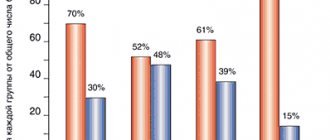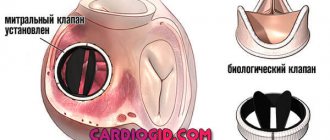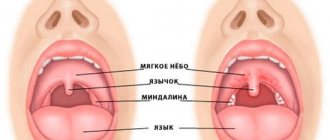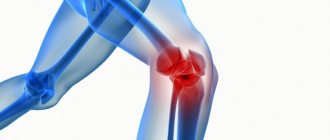For the body to function normally, blood circulation must occur continuously. The blood supply to organs and systems is ensured by the pumping function of the heart muscle, which pushes out 70 - 80 ml of blood (cardiac output) with each systole. In a minute, in an adult with a heart rate of 70 beats, the heart pumps about 5 liters of blood (and in a day - more than 7 tons!).
- Anatomical and functional features of the cardiovascular system
- Acute cardiovascular failure
- Urgent measures
- Drug therapy
- Shock
- Collapse
Kinds
Considering the severity of clinical signs and the course of pathological processes, in medicine acute vascular insufficiency is classified as follows:
| Name | Description |
| Fainting | A pathological condition that occurs suddenly. Depending on the provoking factor, the victim may be conscious or completely unconscious. Properly provided emergency medical care will bring a person to his senses. With complications, convulsions appear. |
| Collapse | The pathological condition is characterized by a severe course and intense clinical symptoms. |
| State of shock | A dangerous condition in which the functioning of internal organs is inhibited. When the brain is damaged, irreversible degenerative-dystrophic changes occur. |
All of the listed types of acute vascular insufficiency are dangerous to human life. They can lead to serious consequences, including the death of the patient due to the development of heart failure.
The state of shock varies according to a certain classification:
| Name | Description |
| Traumatic | A pathological condition that occurs as a result of multiple fractures or extensive soft tissue damage. |
| Anaphylactic | A common cause is a severe allergic reaction of the body. |
| Burn | The pathological condition develops as a result of large area burns. |
| Hematran-fusion | A state of shock develops after a blood transfusion due to Rh incompatibility. |
| Necrotic shock | The cause of the pathological condition is ischemia or necrosis of internal organs vital to humans. |
Treatment of any condition requires a thorough examination and diagnosis; measures will help determine the provoking factor. After its elimination, the victim’s health will gradually recover.
What are the types of heart failure and what are their symptoms?
Heart failure is divided into the following types:
- Left-sided heart failure
- Right-sided heart failure
- Global heart failure
- Systolic heart failure
- Diastolic heart failure
- Chronic heart failure
- Acute heart failure
Each type of heart failure has different symptoms, and the symptoms can vary in intensity. However, the main symptom of heart failure is difficulty breathing during exercise or at rest. Warning signs may include sweating with mild exercise, an inability to lie flat, tightness in the chest, or swelling in the legs.
Left-sided heart failure
The left side of the heart is responsible for pumping oxygen-rich blood throughout the body to the organs. In left-sided heart failure, the pumping function of the left ventricle is limited, resulting in insufficient oxygenated blood to be pumped throughout the body. Instead, the blood remains in the pulmonary circulation, which can lead to fluid in the lungs (pulmonary edema), difficulty breathing, throat irritation, a rattling sound when breathing, weakness, or dizziness.
It is most often caused by coronary artery disease (CHD), high blood pressure or a heart attack, and less commonly by problems with the heart muscle or heart valves.
Left-sided heart failure may present acutely or develop over time. It is usually first noticed by shortness of breath from physical activity. When severe, it can even lead to hypotension (low blood pressure) at rest.
Right-sided heart failure
The right side of the heart is responsible for returning low-oxygen blood back to the lungs. In right-sided heart failure, the right ventricle does not work properly. This causes increased pressure in the veins, forcing fluid into the surrounding tissue. This leads to swelling, especially in the feet, toes, ankles and legs. This can also lead to an urgent need to urinate at night when the kidneys receive better blood circulation.
The cause is most often an acute or chronic increase in pulmonary circulatory resistance. Caused by pulmonary diseases such as pulmonary embolism, asthma, severe emphysema, chronic obstructive pulmonary disease (COPD, most commonly due to tobacco use), or left-sided heart failure. Rare causes include heart valve problems or heart muscle disease.
Global heart failure
When both the left and right sides of the heart are affected, it is called global heart failure. There are symptoms of left and right heart failure.
Systolic and diastolic heart failure
Systolic heart failure is associated with loss of normal functioning of heart muscle cells or external impairment of pumping function. Blood enters the lungs, and the organs do not receive enough oxygen.
In diastolic heart failure, the elasticity of the ventricle is lost, causing it to not relax and fill appropriately. One of the most common causes of diastolic dysfunction is high blood pressure. Due to increased resistance in the arteries, the heart must work harder. The elasticity of the heart muscle decreases, and less blood can be pumped from the ventricles to the body between contractions. This results in the body not receiving enough blood and nutrients.
Heart valve disease can also cause the heart muscle to thicken. The heart muscles become stiffer and less elastic due to the accumulation of proteins. Symptoms range from cough to shortness of breath.
Chronic and acute heart failure
Chronic heart failure is a progressive disease that takes months or years to develop and is more common than acute heart failure. In chronic heart failure, symptoms are often not taken seriously because the body is able to compensate over a long period of time or symptoms are associated with increasing age. Symptoms reflect either left- or right-sided heart failure.
Acute heart failure occurs suddenly, minutes or hours after a heart attack, when the body can no longer compensate. Some symptoms include:
- severe difficulty breathing and/or coughing;
- Gurgling sound when breathing;
- Heart rhythm disturbances;
- Pallor;
- Cold sweat.
Stages and degrees
Depending on the duration of the pathological processes, acute vascular insufficiency is classified into the following stages:
| Name | Description |
| Acute | A pathological condition in which the heart rate drops sharply. Blood pressure also drops quickly and blood circulation in the lungs and heart is disrupted. |
| Chronic | A pathological condition that occurs with prolonged oxygen starvation of brain tissue. |
The state of shock is divided into the following phases:
| Name | Description |
| Short-term erectile | The victim is agitated, constantly screaming, blood pressure is elevated, and heart beats are rapid. |
| Torpid phase | The functioning of the central nervous system is disrupted. The pulse slows and blood pressure drops. |
| Terminal | A person is on the verge of life and death. The indicators are weak. |
In each case, patients develop individual symptoms, which depend on the state of the body and the provoking factor. A person needs immediate medical attention to prevent dangerous consequences.
Sympathomimetics
These substances are used to improve cardiac contractility; they act on adrenergic receptors. Treatment with drugs should be carried out in the intensive care unit or intensive care unit, always under the control of an electrocardiogram.
Dopamine is the most effective remedy for treating insufficient heart function and also combats hypotensive conditions. It helps improve cardiac blood output, constricts large vessels, thereby normalizing the movement of blood through the veins. In small doses (2-10 mcg/kg body weight intravenously, by drip) it improves the functioning of heart receptors within one minute, and a large dose leads to an increase in blood pressure.
Dobutamine - this drug reduces vascular resistance in the periphery, but does not affect pressure, therefore intravenous drip administration is used to treat heart failure, in which there is no pronounced increase in pressure.
Symptoms
The clinical picture of acute vascular insufficiency will help the doctor determine the degree of development of pathological processes and determine the severity of the victim’s condition. Patients develop symptoms depending on the crisis. But there are signs that will help to suspect the onset of acute vascular insufficiency and take timely measures.
Preceding symptoms of acute circulatory disorders:
- general weakness in the body;
- darkening of the eyes;
- nausea;
- muscles relax quickly;
- the person's reaction is inhibited.
Acute vascular insufficiency is accompanied by the following symptoms, taking into account the type of impaired blood circulation:
| Pathological condition | Symptoms |
| Fainting |
|
| Collapse |
|
| State of shock |
|
Symptoms of collapse - acute vascular insufficiency
The main symptom of acute vascular insufficiency is a sharp drop in blood pressure, against which other clinical symptoms appear. After fainting, in most cases, a person comes to his senses safely, and all indicators are restored on their own. However, a repeated attack requires a comprehensive examination and specially selected therapy.
When a state of shock occurs, a person needs urgent hospitalization and emergency medical care. His life is at risk.
Clinical manifestations
The syndrome usually develops suddenly
The clinical picture of AHF is always accompanied by a decrease in blood pressure and directly depends on the severity of the condition; this is presented in more detail in the table.
Table 1. Clinical forms of pathology
| Name | How does it manifest clinically? |
| Fainting woman fainting | The patient suddenly feels weak, dizzy, and has “floaters” flashing before his eyes. Consciousness may be preserved or absent. If after 5 minutes the patient does not come to his senses, then fainting is accompanied by convulsions; as a rule, this rarely happens and with properly organized help the person’s condition quickly normalizes |
| Collapse Retardation during collapse | This condition is much more severe than fainting. The patient's consciousness can be preserved, but there is severe inhibition and disorientation in space. Blood pressure is sharply reduced, the pulse is weak and thready, breathing is shallow and rapid. The skin is pale, acrocyanosis and sticky cold sweat are observed. |
Shock State of shock | Clinically, shock is not much different from collapse, but in this condition a sharp depression of the heart and other vital organs develops. Due to severe hypoxia, the brain suffers, against the background of which degenerative changes can develop in its structure |
Causes
The main cause of acute vascular insufficiency is a disruption in the functioning of the circulatory system.
But there are other provoking factors that result in the development of pathological processes:
- heart disease;
- large blood loss;
- traumatic brain injury;
- severe infection of the human body;
- acute poisoning;
- severe burns;
- organic lesions of the central nervous system;
- long stay in a stuffy room;
- severe stress, emotional overstrain, nervous exhaustion;
- impaired functioning of the adrenal glands;
- severe fear;
- Iron-deficiency anemia;
- heavy loads on the body with severe hypotension, against the background of which the internal organs do not have enough oxygen for normal functioning.
The entire human body is penetrated by capillaries, veins, aortas, large and small blood vessels. When various disorders appear in the human body, blood circulation deteriorates, which affects all internal organs.
Vasodilators and nitrates
Prescribed together with diuretics for pulmonary edema, the substances increase the lumen of veins and arteries, reduce blood pressure, and stimulate myocardial tone.
Nitroglycerin, Nitrosorbide - affect venous vessels, reduce pressure in the ventricles of the heart. The drugs are administered intravenously. Nitroglycerin is used one tablet under the tongue every 10 minutes; to improve the effect, it can be used in the form of a cream or patch on the heart area.
Apressin, Minoxidil - act on arterial vessels, used in the form of tablets, the duration of action is several hours.
Nitroprusside - 0.1-5 mcg/kg body weight per minute is administered dropwise, after administration it begins to act quickly, and just as quickly within a few minutes stops its effect after the dropper stops.
Captopril, Prazosin, Enalapril - these vasodilators affect both venous and arterial vessels, are administered orally, the duration of action is several hours.
When choosing a particular drug, cardiologists take into account the mechanisms of action of substances that affect the bloodstream, and also correlate the effect of the drug and the patient’s condition.
Diagnostics
A comprehensive examination is prescribed to the patient after an examination by a doctor and a preliminary diagnosis. In some situations, the patient requires urgent hospitalization.
Acute vascular insufficiency is a pathological condition in which the circulatory process in the human body is disrupted.
For diagnosis, patients are prescribed the following testing methods:
| Name | Description |
| Electrocardiography (ECG) | A diagnostic method that will help assess the functioning of the heart and identify pathological changes. |
| Auscultation of blood vessels | A doctor listens to a person's heart. The work of the heart is assessed, any abnormalities and rhythm disturbances are determined. |
| Phlebography | The most informative examination method, which involves contrast radiography of blood vessels. Phlebography will help determine damage to the walls of blood vessels and identify the formation of a blood clot. |
| Sphygmography | A modern diagnostic method that allows you to measure arterial pulse and related parameters of the cardiovascular system. |
Timely comprehensive diagnostics will help a specialist quickly identify pathological changes and prescribe effective medications to the victim, and take emergency measures to save a person’s life.
How is heart failure diagnosed?
Diagnosis begins with a comprehensive assessment of a person's medical history, paying particular attention to symptoms (onset, duration, manifestation). This helps classify the severity of the symptom. The heart and lungs are examined. If a heart attack or rhythm disorder is suspected, a 12-lead resting ECG is performed. In addition, echocardiography and complete blood count. The need for catheterization is determined individually.
When to see a doctor
You should visit a general practitioner or cardiologist if any signs of dysfunction of the cardiovascular system appear. Timely diagnosis of pathological processes and properly selected therapy will help prevent dangerous complications.
It could even be the death of a person.
PDT inhibitors
Milrinone - this remedy is also used to relieve symptoms of cardiovascular failure. Its action is to increase myocardial tone. In addition, it acts on the pulmonary vessels, relieving their spasm. The drug is administered via a dropper; first, a loading dose of 50 mcg/kg of human weight is used, then the dose is reduced to 0.35-0.75 mcg/kg in one minute.
Amrinone is a derivative of Milrinone, it has similar pharmacological actions, it also suppresses the effect of the phosphodiesterase enzyme, and acts on the pulmonary and cardiac vessels.
Prevention
Acute vascular insufficiency can be prevented by following simple recommendations from a cardiologist:
- Treat any diseases of the cardiovascular system in a timely manner and under the supervision of a specialist.
- It is strictly forbidden to take medications to eliminate arterial hypertension without a doctor’s prescription.
- It is necessary to avoid prolonged stay in a bathhouse, sauna or in the open sun, especially if a person is in a risk category.
- It is important to give up any bad habits (smoking, drinking alcohol).
- It is recommended to lead a healthy and active lifestyle, play sports, and walk more in the fresh air.
- It is also important to eat a balanced and healthy diet, and add fortified foods to your diet. It is recommended to exclude from the menu all dishes that contain large amounts of cholesterol.
- It is necessary to avoid stressful situations and emotional stress at work and at home.
Preventive visits to a therapist and a comprehensive examination will help monitor the condition of blood vessels and the heart. It is necessary to promptly treat diseases that provoke acute vascular insufficiency.
Treatment of CHF with folk remedies
Treatment of heart failure with folk remedies is possible only under the supervision of the attending physician as an addition to traditional medications. You should not prescribe treatment for yourself on your own, on the recommendation of a neighbor or a friend who has a “similar diagnosis,” and also ignore taking medications prescribed by your doctor, replacing them with folk remedies.
The following herbs are usually used to prepare folk remedies:
- Chopped blueberry shoots;
- Lily of the valley flowers;
- Foxglove leaves;
- St. John's wort herb;
- Parsley seeds;
- Dry ginseng root;
- Hawthorn flowers;
- Motherwort grass and many other plants.
It should be remembered that many of these plants are poisonous. Their incorrect use or failure to comply with the dosage can result in poisoning. Treatment with folk remedies only for symptoms of heart failure, without proper treatment of the underlying disease, will not bring the expected result and may worsen the patient’s condition.
Treatment methods
Acute vascular insufficiency is a serious pathological condition, the treatment of which is carried out taking into account existing clinical signs and the results of complex diagnostics. First of all, the victim must provide emergency assistance and call a doctor.
While the specialist is on his way, perform the following steps:
- Lay the person on his back, lower his head slightly.
- Unbutton your clothes to allow fresh air to flow.
- Give ammonia a whiff.
- Wet your face with cool water.
Then all that remains is to wait for the doctor, who will assess the person’s condition and take all necessary measures, including hospitalization of the victim.
Medications
Therapy in a hospital with medications under the supervision of a physician is carried out to eliminate provoking factors and restore the patient’s condition. The doctor prescribes medications, taking into account the results of the examination, diagnosis and presenting symptoms.
| Group of drugs | Name | Application |
| Phosphodiesterase inhibitors (PDT) | Milrinon, Amrinon | Medicines improve blood circulation. The drugs are administered intravenously. Adult patients are prescribed 50 mcg/kg. |
| Beta blockers | Vasocardin, Bisoprolol | The drugs restore blood pressure and heart rate. To obtain the maximum therapeutic effect, the tablets should be taken in the morning, without chewing and with a sufficient amount of water. Patients are prescribed 50-100 mg 1-2 times a day. |
| Sympathomimetic drugs (pressor) | Dopamine, Dobutamine | Medicines improve cardiac contractility. The drug is administered intravenously through a dropper at 100-250 mcg/min. |
| Cardiac glycosides | Digoxin, Simdax | The medicine should be taken 1 tablet 1-3 times a day. The course of treatment depends on the patient’s condition and lasts on average a week. |
| Vasodilators and nitrates | Nitroglycerin, Captopril | Medicines dilate blood vessels, lower blood pressure and stimulate the tone of the heart muscle. Capsules should be kept under the tongue until they are completely dissolved. Adult patients are prescribed 1-2 tablets. In an emergency, drugs are administered intravenously. |
| Diuretics | Indapamide, Furosemide | Medicines reduce swelling and remove excess fluid from the body. Patients are recommended to take 1 tablet every morning. Do not chew and drink with plenty of liquid. |
| Aldosterone antagonists | Aldakton, Urakton | Patients are prescribed 100-200 mg 2-3 times per day. The course of therapy lasts 3-5 days. |
| Potassium and magnesium supplements | Asparkam, Panangin | The medicine is administered intravenously, 1-2 ampoules (10 ml) 1-2 times a day. Treatment is carried out for 8-10 days. |
| Anticoagulants | Eliquis, Warfarin | The drug should be taken 1 tablet 2 times a day. |
| Metabolic agents | Hypoxene | The medicine is taken orally before meals or during meals with water. The dosage of the drug depends on the body weight of the victim and is 3-12 capsules per day. On average, the course of treatment lasts 7-14 days. |
| Sedatives | Tenoten, Phytosed | It is recommended to suck the tablets or dissolve them in a small amount of warm water. The therapeutic dosage is 1 tablet 1-3 times a day. The course of treatment lasts 1-3 months. |
Additionally, if necessary, detoxification therapy is carried out with intravenous infusion of saline solutions and antidotes. Blood transfusion is indicated for severe bleeding and anemia. Oxygen therapy will help improve metabolic processes and saturate the blood with oxygen.
Traditional methods
Acute vascular insufficiency is a severe circulatory disorder that can be treated with prescriptions from healers and healers, but after stabilizing the person’s condition, under the strict supervision of a specialist. We must not forget about the high likelihood of side effects, allergic reactions or individual sensitivity.
Effective folk remedies:
| Name | Recipe | Application |
| Herbal collection | Mix 1 tbsp. nettle leaves, 2 tbsp. blackcurrant fruits and 3 tbsp. rosehip berries. Pour 2 tbsp. the resulting collection with boiling water (2 tbsp.). Leave for 1 hour and strain. | The finished medicine should be taken orally after meals; you can add a small amount of natural honey for taste. Adult patients are recommended to take 0.5 liters throughout the day. |
| Asparagus | Pour 3 tsp. plants with hot water (1 tbsp.) and leave for 2 hours. | The strained solution should be taken every 2 hours, 1 tbsp. |
| Birch leaves | Pour boiling water (1 tbsp) over fresh or dry crushed leaves of the plant (2 tsp). Leave for 30 minutes and strain. You need to add soda to the resulting broth at the tip of a knife. | It is recommended to take the medicine orally in ¼ tbsp. 4 times a day. |
| Motherwort | Pour the herb (2 tsp) with hot water (500 ml). Leave for 6-8 hours and strain. | The resulting product is consumed orally, ¼ tbsp. 3-4 times a day before meals. |
Herbal teas and infusions restore the functioning of the cardiovascular system and have a positive and calming effect on the central nervous system.
Other methods
Acute vascular insufficiency is a pathological condition that occurs against the background of numerous factors and seriously impairs the patient’s quality of life. Complex therapy, if the patient’s health is stable, involves not only traditional therapy, but also the patient’s compliance with a certain diet.
| Authorized Products | Prohibited Products |
|
|
It is also important to reduce the consumption of table salt, since it retains fluid in the human body and provokes swelling, shortness of breath, and rapid heartbeat. Every day you should drink up to 2 liters of pure liquid to prevent the onset of symptoms of vascular insufficiency.
What causes heart failure?
Heart failure is caused by diseases that affect or damage the heart muscle. The most common cause of chronic heart failure is coronary artery disease.
Coronary artery disease (CAD) is caused by narrowing of the coronary arteries (coronary arteries), most often due to atherosclerosis. Coronary arteries are vessels that supply the heart with oxygen and other important nutrients. Progressive narrowing (also called stenosis) of the arteries leads to poor circulation of the heart muscle. IHD is often diagnosed when angina (chest pain and tension) is present, but otherwise goes undetected.
A heart attack occurs due to decreased circulation of oxygen-rich blood to the heart muscle, leading to irreversible tissue death. This damage affects the pumping function of the heart, leading to heart failure. A large proportion of patients also suffer from high blood pressure, which further aggravates the situation.
High blood pressure (hypertension) is the single cause of heart failure in nearly 20% of people, making it the second most common cause of the disease. High blood pressure causes the heart to constantly work harder. The heart cannot work under additional stress for a long period of time, and therefore deteriorates.
This effect may be caused by a problem with the heart valve. When the aortic valves are narrowed or leaky, the heart must work harder or beat faster, which also increases the workload.
Bradycardia, a heart rhythm disorder in which the heart rate is reduced, can also cause heart failure because too little blood is circulating. A heartbeat that is too fast (tachycardia) is associated with a decrease in stroke volume and can therefore also lead to heart failure.
Inherited heart disease, pregnancy, autoimmune disorders, alcohol, drugs or medication abuse, an overactive thyroid gland and metabolic disorders (diabetes mellitus) can be causes of heart failure.
Possible complications
The prognosis and likelihood of complications in acute vascular insufficiency depends on numerous factors. We are talking about the speed of medical care provided, the individual characteristics of the human body and the provoking factor against which the pathological condition appeared.
A complication may be swelling of the brain, resulting in shock and death of the patient. Acute vascular insufficiency is a dangerous condition in which, if a person remains alive, he should strictly adhere to medical recommendations. This is the only way his health will gradually improve.
Acute vascular insufficiency is a dangerous condition that cannot be dealt with on your own. A thorough examination and correct diagnosis will help prevent complications. Treatment is selected by a specialist, taking into account the test results and the individual characteristics of the patient’s body.
Diuretics
The use of a diuretic for the treatment of cardiovascular failure is very effective, but must be used taking into account the electrolyte balance. The thiazide group of drugs is widely used in medical practice. The peak of action occurs after four hours, the increase in the amount of urine lasts up to 12 hours.
Chlorothiazide is a thiazide diuretic, it is prescribed every 6 hours at a dosage of up to 500 mg. Various analogues of this remedy are also used, they are not distinguished by the presence of advantages with the exception of Oxodolin, it can be used once every 24 hours.
Metozalone - has the same effect as all diuretic groups of thiazides.
Furosemide - the drug also accelerates the formation and excretion of urine, is well absorbed when taken orally in the form of tablets, and is also used for intravenous administration.
All diuretic drugs have side effects in the form of a lack of potassium, since a large amount of it is disposed of along with urine. To avoid hypokalemia, patients are additionally prescribed potassium supplements or therapy is adjusted in favor of potassium-sparing diuretics.
Triamterene, Amiloride - do not have pronounced diuretic effects, but are potassium-sparing diuretics, so they are prescribed in combination with other diuretic drugs.











